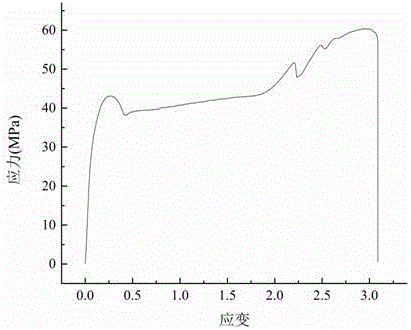Preparation method of nano silicon dioxide reinforced nylon 6 composite
A nano-silica and composite material technology is applied in the field of preparation of nano-silica reinforced nylon 6 composite materials, which can solve problems such as nanoparticle agglomeration, and achieve the effects of improving interface bonding force, enhancing toughness and reducing agglomeration effect.
- Summary
- Abstract
- Description
- Claims
- Application Information
AI Technical Summary
Problems solved by technology
Method used
Image
Examples
Embodiment 1
[0024] Step 1: Stir 186mL of ethyl silicate, 59mL of water, and 59mL of absolute ethanol in a 50°C water bath, add 0.002mol of catalyst hydrochloric acid, and continue stirring for 1 hour to prepare a clear blended solution;
[0025] Step 2: Add 2500g of caprolactam, stir evenly, and gel for 5 hours at a system temperature of 75°C;
[0026] The third step: at a system temperature of 235°C and a system pressure of 0.7 MPa, the ring-opening hydrolysis and prepolymerization of caprolactam are carried out, and at the same time, the gel dehydration of the silicate compound is carried out, and the polymerization time is 2 hours;
[0027] Step 4: Carry out reduced-pressure compression polymerization of caprolactam at a system temperature of 240°C and a system vacuum of 0.1 MPa, and the polymerization time is 4 hours;
[0028] Step 5: Cool and break the prepolymer obtained by polymerization, add 0.024mol of chain extender glycidyl methacrylate, and 0.005mol of molecular weight regulat...
Embodiment 2
[0030]Step 1: Stir 600mL of ethyl silicate, 193mL of water, and 290mL of acetone in a 60°C water bath, add 0.003mol of catalyst hydrochloric acid, and continue stirring for 1.5h to prepare a clear blend solution;
[0031] Step 2: Add 4000g of caprolactam, stir evenly, and gel for 4 hours at a system temperature of 75°C;
[0032] The third step: at a system temperature of 250°C and a system pressure of 0.8 MPa, the ring-opening hydrolysis and pre-polymerization of caprolactam are carried out, and at the same time, the gel dehydration of silicate compounds is carried out, and the polymerization time is 2.5 hours;
[0033] Step 4: Carry out reduced-pressure compression polymerization of caprolactam at a system temperature of 240°C and a system vacuum of 0.1 MPa, and the polymerization time is 4.5 hours;
[0034] Step 5: Cool and break the prepolymer obtained by polymerization, add 0.024mol of chain extender 1,6-hexamethylene diisocyanate, 0.005mol of molecular weight regulator et...
Embodiment 3
[0036] Step 1: Stir 500mL of ethyl silicate, 161mL of water, and 120mL of n-butanol in a 55°C water bath, add 0.006mol of a catalyst sodium chloride aqueous solution, and continue stirring for 1.5h to prepare a clarified blended solution;
[0037] Step 2: Add 7000g of caprolactam, stir evenly, and gel for 4 hours at a system temperature of 65°C;
[0038] The third step: at a system temperature of 215°C and a system pressure of 0.6 MPa, the ring-opening hydrolysis and pre-polymerization of caprolactam are carried out, and at the same time, the gel dehydration of the silicate compound is carried out, and the polymerization time is 2 hours;
[0039] Step 4: Carry out reduced-pressure compression polymerization of caprolactam at a system temperature of 255°C and a system vacuum of 0.08 MPa, and the polymerization time is 3 hours;
[0040] Step 5: Cool and break the prepolymer obtained by polymerization, add 0.048mol of chain extender glycidyl methacrylate and 0.015mol of molecular...
PUM
| Property | Measurement | Unit |
|---|---|---|
| size | aaaaa | aaaaa |
| size | aaaaa | aaaaa |
| size | aaaaa | aaaaa |
Abstract
Description
Claims
Application Information
 Login to View More
Login to View More - R&D
- Intellectual Property
- Life Sciences
- Materials
- Tech Scout
- Unparalleled Data Quality
- Higher Quality Content
- 60% Fewer Hallucinations
Browse by: Latest US Patents, China's latest patents, Technical Efficacy Thesaurus, Application Domain, Technology Topic, Popular Technical Reports.
© 2025 PatSnap. All rights reserved.Legal|Privacy policy|Modern Slavery Act Transparency Statement|Sitemap|About US| Contact US: help@patsnap.com



